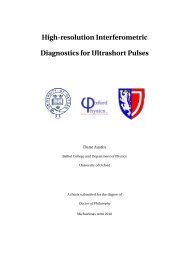Nearly Free Electrons, Tight Binding Model and Semiconductors
Nearly Free Electrons, Tight Binding Model and Semiconductors
Nearly Free Electrons, Tight Binding Model and Semiconductors
You also want an ePaper? Increase the reach of your titles
YUMPU automatically turns print PDFs into web optimized ePapers that Google loves.
We can write the Schrödinger equation in matrix from as〈Ψ|H 0 |Ψ〉 + 〈Ψ|V (x)|Ψ〉 = E (5)Our unperturbed eigenstates are plane waves, |Ψ k (x)〉. Argue that〈Ψ k |V (x)|Ψ ′ k 〉 = V Kδ k−k ′ ,±K (6)The Hamiltonian only acts to connect states with k −k ′ = ±K. Can you see tat this means thetrue eigenstates are superpositions of states from different Brillouin zones? This is known asBloch’s theorem, more on this in class. Unfortunately, this is still an infinite number of states.Ideally, we would like to restrict ourselves to pairs of states with |k| ≈ |k ′ | ≈ |K|/2, as thismakes the problem easy to solve. Why might this be a reasonable assumption? Think aboutthe second order term in perturbation theory: is it large if the unperturbed states have verydifferent energies?Hence show that a state given by |Ψ(x)〉 = a|Ψ k (x)〉 + b|Ψ k−K (x)〉 obeys the Schrödingerequation: ( )¯h 2 k ( 2) ( )2mV K a a= E(7)b bV K¯h 2 (k−K) 22mSolve for the eigenvalues, exp<strong>and</strong>ing to quadratic order in δ = k − K/2. What are the eigenvectorsif k lies on the Brillouin zone boundary at K/2? What sort of waves are these?3 Fermi Surface vs Brillouin Zones3. Consider a 2-dimensional crystal with a simple cubic structure <strong>and</strong> a monoatomic basis. Usingthe free electron model, draw pictures in k-space showing the first Brillouin zone <strong>and</strong> the Fermisurface when the atoms are(a) monovalent(b) divalentShow how the Fermi surfaces are modified when the crystal potential is taken into account.With reference to b<strong>and</strong> structure, explain briefly why:(a) Sodium (BCC crystal with trivial basis) is a metal.(b) Calcium (FCC crystal with trivial basis) is a metal.(c) Diamond (FCC lattice with 2 atom basis) is an insulator whereas silicon <strong>and</strong> germanium,which have similar structures, are semiconductors.4 <strong>Electrons</strong> <strong>and</strong> Holes4. Explain the terms group velocity <strong>and</strong> effective mass as applied to an electron in a crystal. Howcan a negative effective mass be reconciled with the fact that the mass of a free electron ispositive?Consider an electron in a one dimensional energy b<strong>and</strong> E(k x ), where k x is the wavevector alongthe x-direction. An electric field F is applied along the x-direction. Show that the equationdescribing the motion of the electron along the x-direction is¯h dk xdt= −eF (8)Derive an expression for the effective mass in terms of the b<strong>and</strong> structure E(k x ).What is a hole? Why is the concept useful? How are the properties of holes related to those ofthe electron state to which they correspond?2
5. Briefly summarize (in a couple of sentences for each) how to find the following properties of asemiconductor experimentally:(a) The sign of the majority charge carrier.(b) The concentration of charge carriers.(c) The b<strong>and</strong> gap.(d) The effective mass.(e) The mobility of the majority carrier.5 <strong>Semiconductors</strong>: Doping <strong>and</strong> the Law of Mass Action6. Explain the principle of doping a semiconductor with impurities to produce an excess of electronsor holes. Give an example of a suitable material with which to dope silicon to producean excess of electrons. [7]Give expressions for the density of free electrons (n) <strong>and</strong> holes (p) in a semiconductor in termsof the density of states in the conduction <strong>and</strong> valence b<strong>and</strong>s <strong>and</strong> the Fermi-Dirac distributionfunction. [4]Using the free-electron form of the density of states <strong>and</strong> approximating the Fermi-Dirac distributionfunction in each case by an exponential, derive an expression for the hole <strong>and</strong> electrondensities as a function of temperature <strong>and</strong> Fermi energy in a semiconductor with a b<strong>and</strong> gapE g <strong>and</strong> electron <strong>and</strong> hole effective masses of m ∗ e <strong>and</strong> m ∗ h. Show that the results give a productnp which is independent of the Fermi energy E F . [9]A material with E g = 1 eV <strong>and</strong> m ∗ e = m ∗ h = 0.1m e is doped with 1 × 10 23 m −3 shallow donorimpurities. Calculate the density of holes present at room temperature. [5][ ∫ ∞dx x 1/2 e −x =0√ π2](9)[1996 A4 question 5 (old course)]7. Explain what the terms direct gap <strong>and</strong> indirect gap mean when used to describe semiconductors.Show that the number of electrons per unit volume in the conduction b<strong>and</strong> of an intrinsic gapsemiconductor at a temperature T is given by( )n = AT 3/2 −Egexp(10)2k B T[5]where E g is the energy gap <strong>and</strong> A is a constant which need not be evaluated. [10]The Hall coefficient R H for a sample of undoped silicon is measured to be 625 m 3 C −1 at 300K<strong>and</strong> 0.016 m 3 C −1 at 500K. Assuming only one type of carrier contributes to R H deduce avalue for E g from these data. [6]The optical absorption of silicon as a function of photon energy exhibits large increases at 1.2eV <strong>and</strong> 3.3 eV . Comment on your value for E g in relation to these optical data. [4][2000 A4 question 4 (old course)]3









![Extended Notes 8 [pdf]](https://img.yumpu.com/50123548/1/190x245/extended-notes-8-pdf.jpg?quality=85)




![Handout 3 [pdf] - University of Oxford Department of Physics](https://img.yumpu.com/46475432/1/190x245/handout-3-pdf-university-of-oxford-department-of-physics.jpg?quality=85)